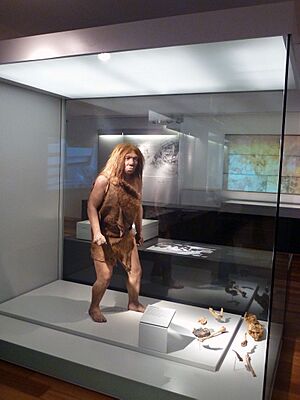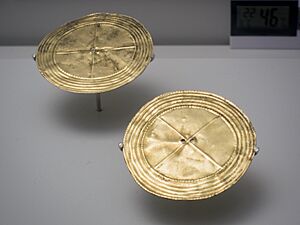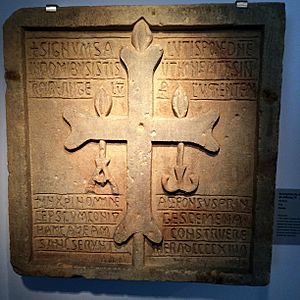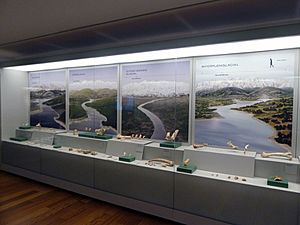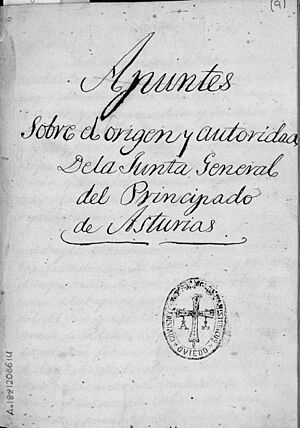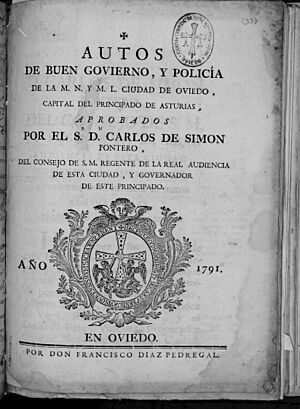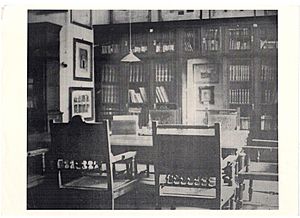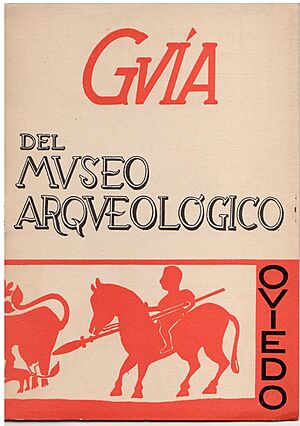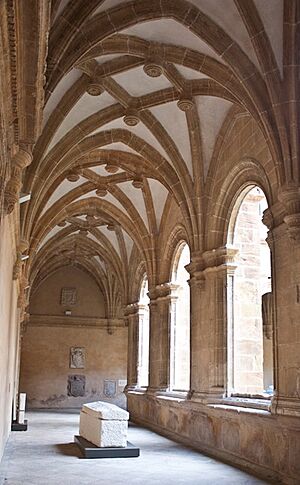Archaeological Museum of Asturias facts for kids
| Museo Arqueológico de Asturias | |
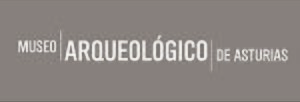 |
|
 |
|
| Established | 1952 |
|---|---|
| Location | Calle San Vicente 3 and 5 Oviedo, Asturias, Spain |
The Archaeological Museum of Asturias (in Spanish: Museo Arqueológico de Asturias; in Asturian: Muséu Arqueolóxicu d'Asturies) is a cool place to explore history! It's located in Oviedo, Asturias, Spain. The museum is inside a really old building, a Benedictine monastery from the 1500s.
This museum shows off amazing collections from different times in history. You can see items from the Stone Age, Bronze Age, and Iron Age. There are also pieces from the Roman period and the time of the Kingdom of Asturias. The museum even has sections about local traditions, old writings, coins, medals, and armor.
The Spanish government owns the museum. But since 1991, the local government of Asturias has been in charge of running it. The museum got a big makeover starting in 2004. It reopened its doors to the public on March 21, 2011, looking brand new!
Contents
Cool Things to See
Here are some special items you can find at the museum:
- The Vega del Cielo mosaic, a beautiful ancient artwork.
- Altar stones from famous old churches like San Miguel de Lillo and Santa María del Naranco.
- A sarcophagus (a stone coffin) from the 1100s. It belonged to Gontrodo Pérez, who was the mother of Urraca la Asturiana.
Exploring History: Permanent Exhibits
The museum's main exhibit tells the story of the Asturias region. It covers everything from prehistoric times to the Middle Ages. You'll learn about the different people who lived here over thousands of years.
Life in Prehistoric Times
Scientists have found out how early people lived. They hunted, fished, and gathered food. They also made tools. You can see how Neanderthals lived, thanks to discoveries from the El Sidrón cave in Asturias. Early humans also created amazing cave art. In Asturias, there are nearly 50 caves with drawings and paintings of animals and symbols.
From Stone Age to Metal Ages
Around 4,500 years ago, life changed a lot. People started farming, clearing forests, and raising animals. They also built huge stone structures called megaliths. These were important for rituals and marking land. People began mining copper, which led to new tools and more complex societies. This was the start of Asturias' long history as a mining area.
The Era of Castros
Castros are old fortified villages. They are a common sight in the Asturian landscape. People lived in castros from the end of the Bronze Age until the Romans arrived. These villages had strong defenses. They show that communities were often separate and organized into different groups or clans.
Rome Comes to Asturias
When the Roman Empire arrived, Asturias became part of their vast territory. The Romans connected towns and villages with a big network of roads. They were very interested in the gold mines in the western part of the region. New businesses and trade started, changing how people lived. The Romans also brought their culture, linking Asturias to the wider classical world.
Medieval Asturias
The Kingdom of Asturias began in the Middle Ages. Kings, churches, monasteries, and castles were important centers of power. Most people lived in small villages in simple homes. The art from the Asturian monarchy is known for its unique buildings and decorations. Later, new towns grew, becoming centers for government, trade, and crafts. New churches were built in the Romanesque and Gothic styles. Towards the end of the Middle Ages, powerful families became very important in the region.
The museum also has a section called "From Collection to Museum." It explains how the museum started and how archaeology developed in Asturias. There's also a special tribute to Friar Benito Feijoo y Montenegro. He was a very smart writer from the 1700s. You can see a recreated Benedictine monk's room, just like his.
Another part of the museum helps you learn about Asturias' World Heritage sites. These include ancient cave art and monuments from the Asturian monarchy. Interactive screens and videos give you lots of information. They also show you different routes to explore these historical places.
The Museum's Collection
The museum's collection started growing in the 1800s. When churches lost their property in 1837, many religious artworks became available. A group called the Asturian Commission on Monuments began collecting items from abandoned churches and monasteries. People also donated their own collections.
At first, the museum focused on restoring old churches. They collected pieces from damaged buildings. In the 1900s, as archaeology became more scientific, the museum started looking for prehistoric items, especially after ancient cave art was found in Asturias.
Throughout the 20th century, the collection grew a lot from archaeological digs. Private collections were also given to the museum. In the 1960s and 70s, the local government bought many wooden statues, furniture, and other objects. Important purchases included a collection of archaeological artifacts, a coin collection, and a collection of weapons and coins.
Since the 1970s, new research has added many items from the Stone Age, Metal Ages, and Roman period. In the 1990s, "management archaeology" became important. This means that before building new things, archaeologists check the ground for historical items. This has brought in many objects from all time periods, especially from the Middle Ages. These items come from old city centers, churches, and monasteries that were studied before being restored.
The Museum Library
The library at the Archaeological Museum of Asturias is a special place for learning. It helps people study prehistoric times and archaeology in Asturias. The library has many books and documents related to the museum's collections. It has a computer catalog and a reading room for visitors.
The library has always been important to the museum. It has changed a lot since the mid-1800s, just like the museum itself.
Library Goals
The library has several important goals:
- To keep the museum up-to-date.
- To collect, organize, and share information for studying the museum's items.
- To protect and save its old documents.
- To combine its archives and library into one main information center.
- To share its resources through publications and its website.
- To work with other organizations.
- To use new technology to improve services for visitors.
Library Space
The library is located between the first and second floors of the museum. You reach it by using the old stairs of the monastery. It has two main areas: one for reading and one for storing books. The reading area has seven seats where you can look at books and archive materials. You can also use the internet and print things if you need to. There's also a workspace for the library staff.
The library is open to everyone from Monday to Friday. This means more people can use its resources now. It's also a flexible space where meetings and workshops can be held.
What's in the Collection?
The library specializes in archaeology, prehistory, and ancient and medieval history, especially about Asturias. You can find its catalog online. The collection includes books from 1650 to today. It has about 15,000 items, including books, magazines, maps, images, videos, drawings, and even old handwritten letters. Most items are in Spanish, but there are also publications in English, French, and Italian.
- Old Books (Historical Fund): This section has about 3,500 items collected between 1844 and 1952. They cover topics like old writings, coins, classical archaeology, and Asturian history. Many were printed between 1870 and 1930. Some came from purchases, donations, or exchanges with other historical groups. There are French art encyclopedias and works about early archaeological digs. A very special work is "Architectural Monuments of Spain," which aimed to study and share Spain's artistic heritage. It was published between 1856 and 1881. The library also has documents in the Asturian language, poems, and handwritten texts.
- General Collection:
This part has about 9,000 books and reference materials. It covers many subjects, but history and art, especially about Asturias, are the most common. You'll find textbooks, reports from archaeological digs, exhibition catalogs, and research papers. The museum is responsible for protecting archaeological objects found in Asturias. It also promotes research. So, the collection has many reports about archaeological sites. Since the 1980s, there have been many publications about archaeological projects and conservation work.
- Magazines and Journals (Periodic Publications): The library has 152 different magazine and journal titles. Many come from exchange agreements with over 70 organizations in Spain and other countries. Some are very old, from before 1900. Others are from the early 1900s. Since 1944, the library has worked hard to keep its collections updated. Many journals are donated. However, due to recent economic changes, more people are now reading digital magazines online.
- Other Materials: The library also keeps the archives of the Commission of Monuments, with documents from 1840. This includes old photos, drawings, diplomas, and local newspapers. The museum's modern image archive has about 5,000 photos of archaeological items.
Who Uses the Library?
The library at the Archaeological Museum of Asturias is used by many different people:
- Museum staff.
- Students studying art history, history, and museology.
- Tour guides and cultural information providers.
- University professors.
- Archaeologists and historians who work with the museum.
- Researchers.
- People interested in local history.
- Other organizations that need information for their users.
- Experts who organize exhibitions about specific times and places.
Library Services
The library at the Archaeological Museum has changed a lot. It's no longer just a place to store books. It's now a hub for researchers. Just like museums are more than just places to keep objects, libraries are more than just book warehouses. They are active spaces for learning and discovery.
Museum History
How the Museum Started
The idea for the museum began in 1845 with the Provincial Commission on Monuments. This group worked to protect Asturias' historical sites. They opened the first museum in 1870 in an old convent. It displayed items collected from around Asturias and donations.
The current museum officially started in 1944. But it didn't open to the public until 1952. It was located in the cloister (a covered walkway) of the old Monastery of San Vicente. The collection grew with new discoveries, donations, and purchases. In 1998, the government decided to renovate and expand the museum. Work began in 2004. After spending 16 million euros, the museum's size grew to 5,810 square meters. About 2,013 square meters are used for the permanent exhibits.
During the renovation, workers found a 1.6-meter-high part of Oviedo's original city wall from the 700s! The cloister's arches actually rest on these old wall remains. The building plans had to be changed to show off this amazing discovery. This find supports a historian's idea about where King Alfonso II's wall once stood.
History of the Library
The library of the Archaeological Museum of Asturias started with the Provincial Commission of Monuments in 1844. After church properties were taken by the state in 1836, there was a need to protect historical buildings and art. The commission aimed to save cultural heritage, collect information about monuments, and care for books, documents, and other treasures.
To understand the library's journey, we need to look at the museum's different locations and events.
The Library with the Commission Museum (1844–1878)
The first collection began over 150 years ago as a small helper library. Librarians from the University of Oviedo took care of it. In 1868, the Chapel of the Third Order of the Convent of San Francisco in Oviedo was chosen to house the museum and library. It took seven years to get it ready.
The Library with the Antiquities Museum (1878–1918)
On September 21, 1878, the museum opened in a small space of 124 square meters. The library was a key part of the museum. As Fermin Canella Secades said in 1882, it had "enriched enough in these last years, with books of history, archaeology, fine arts." It included a special section of Asturian historical papers.
In 1889, the museum moved to the Normal Schools, with a larger space of 215 square meters. One room was for the archive and library, and another for meetings. In 1902, the library opened to the public and allowed books to be borrowed. But the Normal Schools needed more space, so the library moved again.
The Library with the Provincial Museum (1918–1951)
In 1918, the library moved to a temporary location on the ground floor of the Dean's house. From then on, the library, archive, and museum collection had limited access. This protected them from damage during the Revolution of October in 1934 and the Civil War. In 1939, the local government began rebuilding the Benedictine Monastery of Saint Vicente. This would become the museum's permanent home.
The Library with the Provincial Archaeologic Museum (1952–2003)
On San Mateo's day in 1952, the museum officially opened. The library had an important place in this new building. The museum director also managed the library. The library started a new phase, collecting more books and building relationships with national and international groups to exchange publications. In 1972, the original commission disappeared, and its tasks were taken over by the local government. In 1991, the management of the Provincial Museum was transferred to the Government of Asturias.
The Library with the Archaeological Museum of Asturias (2011–)
After being closed for 8 years for renovations, the Archaeological Museum of Asturias reopened on March 21, 2011. It was in its historic building, which had been restored and expanded. The museum now has a modern permanent exhibition and new facilities. With this renewal, the library also became modern. It opened to the public, its catalogs became available online, and its old collections started to be digitized.
The Museum Building
Since 1952, the museum has been in the cloister of the old Monastery of San Vicente. This building has a long and interesting history connected to the city's beginnings. The cloister was declared a national monument in 1934.
The Monastery of San Vicente is thought to have been founded in 761, during the time of King Fruela I. Only small parts of that first building remain. However, the cloister, which was started in the 1530s, is still standing. It was built by master builders Juan de Badajoz, the Younger, and later finished by Juan de Cerecedo, the Elder, and Juan de Cerecedo, the Younger, in the 1570s.
See also
 In Spanish: Museo Arqueológico de Asturias para niños
In Spanish: Museo Arqueológico de Asturias para niños
- Archeological Museum of Asturias' Library
- List of museums in Spain


